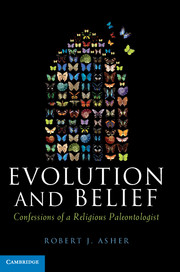Book contents
- Frontmatter
- Contents
- Acknowledgments
- Prologue
- One Science and Religion
- Two Evolution as a Science
- Three Characters and Common Descent
- Four The Fossil Record
- Five The Roots of Mammals
- Six A Brief History of Elephants
- Seven Whales are no Fluke
- Eight Creationism
- Nine DNA And The Tree pf Life
- Ten DNA and Information “Creation”
- Eleven Biology and Probability
- Twelve Evolution, Education, and Conclusions
- Notes
- Bibliography
- Index
Eleven - Biology and Probability
Published online by Cambridge University Press: 05 March 2012
- Frontmatter
- Contents
- Acknowledgments
- Prologue
- One Science and Religion
- Two Evolution as a Science
- Three Characters and Common Descent
- Four The Fossil Record
- Five The Roots of Mammals
- Six A Brief History of Elephants
- Seven Whales are no Fluke
- Eight Creationism
- Nine DNA And The Tree pf Life
- Ten DNA and Information “Creation”
- Eleven Biology and Probability
- Twelve Evolution, Education, and Conclusions
- Notes
- Bibliography
- Index
Summary
Much in the popular debate about life’s evolution revolves around our own perception about what is likely, or what could and could not happen in nature without the intervention of a human-like, purposeful agent. It’s therefore worth having a look at probability, and to consider the kinds of things that you and I could agree upon as probable, or not, under certain circumstances.
Take five six-sided dice and roll them. The odds that you’ll come up with a 1, 2, 3, 4, and 5 in a single roll are 65, or 1 in 7776. If it took four seconds each time you gathered up the dice and rolled them, on average you’d get only one such result every 8.6 hours of continuous rolling. In the scheme of a single game involving dice, this is an improbable event, but given lots of humans spending many hours rolling dice, a result such as this would actually occur quite frequently. Hence, something that seems at first glance to be very improbable may be boringly common when a little time and extra protagonists are added.
Let’s take a much more improbable event: rolling 1, 2, 3, 4 and 5 three times consecutively. This amounts to the previous probability, 1 in 7776, multiplied by itself three times: 77763 , or 1 in 470,184,984,576. On average, you would achieve one such combination about every 522,427,761 hours (61,000 years) of continuous rolling, again at four seconds per roll. The participation of many humans rolling dice simultaneously would substantially increase the probability of obtaining this result within a set period of time; after all, there are nearly seven billion of us and with everyone at work someone would probably make this unlikely set of rolls without too much delay. But all you have to do is start increasing the number of successive occurrences of 1, 2, 3, 4, 5 and even a world full of eager humans rolling dice would be ever more unlikely to hit upon the magic sequence.
- Type
- Chapter
- Information
- Evolution and BeliefConfessions of a Religious Paleontologist, pp. 201 - 219Publisher: Cambridge University PressPrint publication year: 2012



